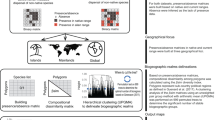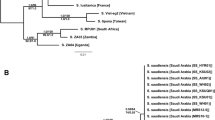Abstract
The identity and origin of the West Indian plague ants of the early sixteenth and late eighteenth centuries have long been a mystery1. By reviewing historic accounts with an analysis of the present-day Caribbean ant fauna, I have narrowed the list of suspects to two species and their insect symbionts.
Similar content being viewed by others
Main
During, or soon after, 1518–19, a plague of stinging ants hit the fledgling Spanish settlements on Hispaniola, the second largest island in the Greater Antilles. According to an eyewitness account by the premier colonial historian Bartolomé de Las Casas2, the insects destroyed crops over a substantial portion of the island and invaded dwellings. During 1760–70, similar ant plagues spread through the Lesser Antilles, reducing sugar-cane fields to “a state of the most deplorable condition”3.
What were the plague ants, and why did they multiply to such proportions? I investigated these questions during field work on the historic plague islands, paying particular attention to species that might be descendants of the plague ants. I also combed contemporary accounts of the ants and fitted together information concerning their appearance and habits, which I matched against that of the now reasonably well-known modern ant fauna. By a process of elimination, I narrowed the list of fauna to candidates with all of the available defining traits.
The Hispaniolan plague ant is easily characterized from the first-hand account of Las Casas2. The ant he described was very aggressive; it had a painful sting; it occurred in dense populations in the root systems of shrubs and trees; it did not cut above-ground vegetation yet somehow damaged the root systems; and it was also a pest in houses and gardens. The only species also present in the modern West Indian ant fauna that has all these qualities is the tropical fire ant, Solenopsis geminata. This inference is strengthened by the fact that another fire-ant species, S. invicta, attained plague proportions in the Gulf states in the 1940s, following its introduction from the La Platte region of Brazil and northern Argentina4.
The 1760–70 plague ants of the Lesser Antilles had the same traits as S. geminata save two: in the several accounts of these species, including details from an eye-witness on Grenada5, there is not a single mention of defensive aggression or of stinging by the ants. An attack by swarms of fire ants is unavoidable if an intruder nears their nests, and would surely have been mentioned by anyone who had experienced it. And a fire-ant sting contains a venom that burns, creating a small, itching welt, which would presumably also have been reported.
There is one possible clue: on Barbados in the mid-1600s there was an ant that was a serious house pest. Unlike fire ants, its workers lifted and carried large food items, such as cockroaches, in an unusually coordinated fashion. This feature points to the ant genus Pheidole. Among the many species known from the West Indies6, only two are candidates: P. jelskii, a native species, and P. megacephala, which is of African origin. The evidence favours P. megacephala, a global, invasive ant that has caused similar problems in other tropical countries7.
A puzzle remains: only the attine leafcutter ants of the New World are known to attack vegetation as an important source of food, yet entire plantations on Hispaniola were wiped out “as though fire had fallen from the sky and scorched them”, records Las Casas2. Sugar cane in the fields of the Lesser Antilles likewise disappeared in the 1760s (ref. 3).
The only viable hypothesis is that the ants had a symbiotic relationship with insects that attack plants directly. The two plague-ant suspects, S. geminata and P. megacephala, heavily attend sap-sucking coccids, mealy bugs and other insects of the Homoptera group7. The ants protect these insects in exchange for their abundant excrement, which is rich in sugar and amino acids. The Spanish, not recognizing the role of the homopterous sap-suckers in the midst of the myriad kinds of insect teeming around their crops, would understandably put the blame on the stinging ants. It was not until the late eighteenth century, on Grenada, that naturalists began to suspect the involvement of homopterans in the West Indian ant plagues5.
References
Wheeler, W. M. in Translation of Histoire des Fourmis (de Réaumur, R. A. F., unpublished, 1742–43) 232–239 (Knopf, New York, 1926).
de Las Casas, B. in Historia de las Indias III, Capítulo CXXXVIII, 270–271 (Impr. de M. Ginesta, Madrid, 1875–1876).
Schomburgk, R. H. in History of Barbados 640–643 (Longman, Brown, Green and Longmans, London, 1848).
Lofgren, C. S. & Vander Meer, R. K. (eds) Fire Ants and Leaf-cutting Ants: Biology and Management (Westview, Boulder, Colorado, 1986).
Castles, J. Phil. Trans. R. Soc. Lond. 16, 688–694 (1804).
Wilson, E. O. Pheidole in the New World: A Dominant, Hyperdiverse Ant Genus (Harvard Univ. Press, Cambridge, Massachusetts, 2003).
Hölldobler, B. & Wilson, E. O. The Ants (Belknap, Harvard Univ. Press, Cambridge, Massachusetts, 1990).
Author information
Authors and Affiliations
Corresponding author
Ethics declarations
Competing interests
The author declares no competing financial interests.
Rights and permissions
About this article
Cite this article
Wilson, E. Early ant plagues in the New World. Nature 433, 32 (2005). https://doi.org/10.1038/433032a
Published:
Issue Date:
DOI: https://doi.org/10.1038/433032a
This article is cited by
-
Booms, busts and population collapses in invasive ants
Biological Invasions (2016)
-
How common are invasion-induced ecosystem impacts?
Biological Invasions (2011)
Comments
By submitting a comment you agree to abide by our Terms and Community Guidelines. If you find something abusive or that does not comply with our terms or guidelines please flag it as inappropriate.



